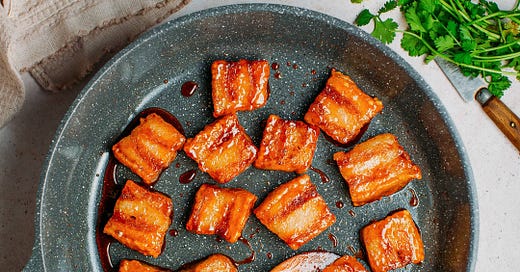by Kim Odhner
In recent years, Vietnam’s cuisine has launched into the global culinary scene capturing the cravings and imaginations of hungry people worldwide, however, it was not that long ago that its culinary history experienced darker days. Biting into a delicious banh mi sandwich recently, I was reminded of one of my earliest experiences with Vietnamese food. My first visit to the country was in 1994, and while visiting a factory, my hosts served me a cold boiled pig’s ear in a bowl. Grappling with my “lunch,” I felt a combination of revulsion and insult as I attempted to pierce the rubbery organ with my canines, while my hosts looked on expectantly.
Although I have been vegetarian now for many years, when I reflect on that time, I am ashamed that I was not more empathetic to the fact that I was being served a coveted morsel of protein in a country that was then among the poorest in the world, having only recently emerged from decades of diplomatic isolation. Vietnam’s emergence from poverty, as positive as it is, provides a perfect case study of explaining our keen focus on the protein transition as a humane and necessary antidote to our climate crisis.
15 years later, in 2008, I served on the board of an animal feed company that imported the first “Large White” breeding boars and established the first integrated, feed-to-slaughter production facility in the country.
Fast forward another 15 years to today, and Vietnam is now the highest per-capita consumer of pork in the world, ahead of China. In a short 30-year period, the country has gone from “famine to feast,” producing 4.5 billion metric tons of pork, compared to a mere 1 million in 1994. That production level requires massive amounts of imported soybeans and produces untold levels of noxious waste.
While a precipitous rise in meat consumption in one country may seem catastrophic for our efforts to save humanity, Asia, paradoxically, may hold the key to helping reverse this trend. Asia is, after all, home to the largest vegetarian population in the World. Across the region, its principal religious traditions encourage periods of meat avoidance, if not outright abstention. The continent is known for its various forms of alternative proteins common to everyday consumption, most notably tofu, invented by the Chinese over 1,000 years ago. Asia is also home to some of the world's fastest-aging countries, led by Japan and South Korea, followed by Singapore, Thailand, China, and Taiwan, which also have shrinking populations. It is precisely this combination – tradition, ebbing populations, and openness to alternatives – that holds the greatest promise for an eventual decline in dependence on animal proteins.
These longer-term demographic and cultural trends suggest that we may see a decline in the demand for animal proteins over time. However, with the benefit of local intuition and investment in innovation, I believe we can help to further accelerate these trends within the region, irrespective of the trajectory of individual constituent countries like Vietnam.
In order to accelerate this transition, we need to start by focusing on opportunities that are simple to identify and represent the priorities of Asians. For example, we have known for some time now that, although dairy use is widespread, most Asians are largely lactose intolerant. Yet, until very recently, there were virtually no locally produced non-dairy cheeses and beverages. Additionally, I often hear that “Asian consumers want protein innovations in applications, formats, and with flavors that are localized to suit their consumption habits.” This point was brought home for me by a Chinese colleague who shared that “Westerners are trying to sell us Beyond Burgers, while Chinese consumers are more concerned with finding ways to extend the shelf-life of tofu!”
Ultimately, by listening to Asians and continuing to promote non-animal protein solutions, we have an opportunity to create a positive climate impact in one of the most populous regions of the world.





